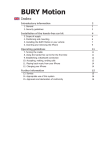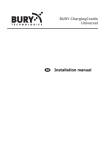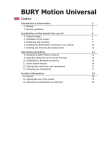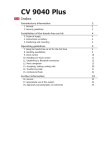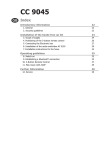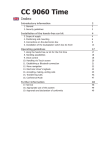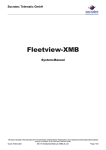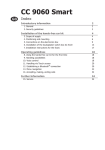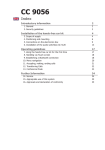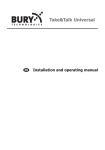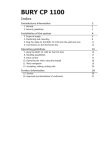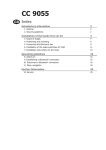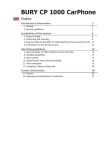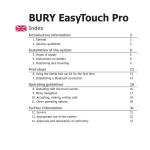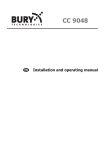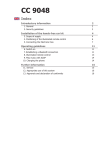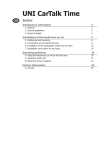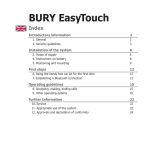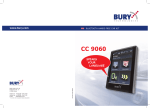Download CC 9068 App Manual EN
Transcript
CC 9068 APP Index Introductory information 1. General 2. Security guidelines Installation of the hands-free car kit 3. Scope of supply 4. Positioning and mounting 5. Charging the phone in the cradle 6. Connections on the electronics box 7. Starting the BURY ChargingCradle Universal 8. Inserting and removing the mobile phone 9. Rotating the cradle 10. Initialising the BURY ChargingCradle Universal Operating guidelines 11. CC 9068 App software installation 12. Handling possibilities 13. Voice control 14. Handling via Touch screen 15. Establishing a Bluetooth connection 16. Menu navigation 17. Accepting, making, ending calls 18. Transferring Calls 19. Conference Mode 20. Different smartphone’s specific features Further Information 21. Service 22. Appropriate use of this system 23. Approvals and declaration of conformity 2 2 2 4 4 6 8 9 12 16 18 18 19 19 20 20 21 22 23 38 39 39 41 42 42 43 43 Introductory information 2 1. General Dear customer, Congratulations on purchasing a BURY hands-free car kit. You have chosen a high quality product that is extremely easy to use. Please read the operating manual carefully so that you can fully enjoy your BURY hands-free car kit. If you have any further questions concerning installation or operation of your car kit, please contact your dealer. He will be happy to give you reliable advice. You can also contact our hotline. Our phone and fax numbers are listed in the chapter Service at the end of the operating instructions. Have a good trip! 2. Security guidelines Installation - who should do it The installation of this system can be carried out by yourself but please observe the installation requirements of the automotive manufacturer (VAS 1978). During the installation, park the car at a place where the road traffic is not impaired. We recommend to let a specialised workshop perform the installation. Power supply This system has been designed for the use in vehicles with an on-board supply system of 12 volts (passenger car). If you intend to install the device in a vehicle with an on-board supply system of 24 volts (lorry), please use a voltage converter. If you have queries regarding this subject, please contact our hotline. Position, volume Install the components of the device in the vehicle so that your field of vision is not impaired and the components are not mounted in the impact zone of the passenger compartment or in the airbag inflation zones. The removal of coverings (with and without airbags) or components of the dashboard requires – in some cases – special tools and special knowledge. 3 Intended use We shall not be liable for damages or malfunctions due to improper use of the hands-free system. Therefore, do not expose the device to moisture, extreme temperatures or shocks and carefully follow the procedure described in the installation and operating guidelines. Note: XXCC 9068 APP works with touch controlled smartphones only! Use while driving Operate the system only when the situation allows it and when you do not endanger, harm, constrain, or annoy other road users. The volume of the device has to be set in a way that exterior noise is still audible. Faults Do not commission the device if you detect or assume a defect. In this case, contact a Bury specialised dealer or our hotline. Improper repair efforts can be dangerous for you. Therefore, only skilled personnel may perform inspections. Important: XXThe driver is ultimately responsible for the safe operation and control of their vehicle at all times. You should never use a hand held phone, including sending or reading text or picture messages, while driving. XXResearch indicates that there is a risk to safety when the driver of a motor vehicle is distracted and using a mobile phone while driving can be a distraction. XXThe manufacturer strongly recommends that you use a hands-free solution when driving. Avoid exposure to long periods of direct sunlight when vehicle is parked as this can cause, among others, damage to the readability of the display. The sound functioning of the display is guaranteed up to a maximum temperature of 60° C. 4 Installation of the hands-free car kit 3. Scope of supply 8 9 12 10 11 13 5 The CC 9068 APP is supplied with different combinations of components, depending on the sales regions (countries). The operating manual refers to all versions. Description of the components: 1) Electronic Box 2) Cradle 3) Set of tips for specific mobile phone models 4) Dash Mount Adapter for installation on the dashboard or console 5) Little Flat antenna with fakra-connection 6) Microphone 7) ISO cable harness 8) Extension cord 9) Micro USB charging cable 10) AUX IN cable 11) Quick user guide 12) Mobile phone and Smartphone-specific charging cable (does not occur in the kit, is available as an accessory) 13) External loudspeaker Version 1: - without external loudspeaker Version 2: - with external loudspeaker Note: XXIf certain components are added or omitted you will receive the corresponding information on a separate enclosure. Installation of the hands-free car kit 6 4. Positioning and mounting Important: XXWhen positioning the cradle please take care that the device does not impair the view onto the road, that it will not be installed in the impact zone of the passenger compartment (amongst others in the airbag inflation zones) and that the cable may be laid without any problems. XXPlease avoid direct sunlight on the device or high internal temperatures, which can be rapidly reached in parked vehicles. In such cases, remove the cradle and put it in the car glove pocket or glove box for instance. Step 1: Attaching the Dash Mount Adapter. Variant A: 7 Variant B: For the fixing of the Dash Mount Adapter, depending on the type and brand of your car, specific attachment systems (consoles or other assembly aids) can be purchased from local retailers. Step 2: Connecting the BURY ChargingCradle Universal with the Dash Mount Adapter. Push the BURY ChargingCradle Universal in the Dash Mount Adapter until you can feel it click into place. 8 Installation of the hands-free car kit Note: XXYou will find the same snap-in mechanism on the Window Mount as you do on the Dash Mount Adapter. Step 3: The Little-Flat Antenna mounting. The preferred position for on-glass antenna is either on the upper right side or upper left side of the windshield, opposite from the driver´s seat. Important: XXEnsure the antenna is located at least 20 cm away from driver and passengers. XXTo avoid audio interference, do not thread the antenna cable close to the microphone cable. 5. Charging the phone in the cradle If a corresponding cable is connected to the telephone, the smartphone that is positioned in the BURY ChargingCradle Universal cradle will be supplied with electrical power (please refer to the picture). The conduction of the electricity supply occurs from the electronic box. 9 6. Connections on the electronics box The other components of the hands-free car kit are connected to the electronic box. You can find the following connections: Connection possibilities: 1 CHARGING PORT: Micro USB socket to connect the extension cable - the charging cable or an optional update cable can be connected there 2 PWR/LSP/LINE OUT: 24-pin socket for the connection of the molex jack from the ISO cable harness, used as power supply of the hands-free car kit outputs music and voice (telephone) 3 MICROPHONE: Connection for external microphone 4 LINE IN: Connection for AUX-IN cable for inputting of music 5 DISPLAY: Connection for display (if present) 6 REMOTE CONTROL: Connection for remote control with 3 buttons display (if present) 1 - CHARGING PORT An extension cable with safety pin for BURY ChargingCradle Universal is connected to connection no. 1 (micro USB socket). The other end of the cable can be connected to both micro USB sockets of the holder BURY ChargingCradle Universal. 2 - PWR/LSP/LINE OUT The hands-free car kit in the vehicle is connected to the car radio with the ISO cable harness. If the radio has ISO socket at its backside, the installation can be done without additional installation material. If not, certain adapters, e.g. ISO2CAR or AUDIO2CAR, can be ordered from an authorised dealer for the respective radio or vehicle make. 10 Installation of the hands-free car kit Using the ISO cable harness, you can input music and voice signals (telephone) of different types into the radio or play them back via the radio. If the present radio has a LINE-IN or AUX-IN input at the front side or backside, the four open LINE cables of the ISO cable harness can be connected to them using appropriate adapters (e.g. 3.5 mm stereo jacks or cinch connectors). The radio amplifier is used for music playback in that case. Please observe the notes in the instruction manual of the radio concerning „AUX input“. Generally, voice signals are only output in the two front loudspeakers while music is played back on all four loudspeakers (front and rear). Different installation options can be selected with the hands-free car kit for that purpose. Toggling between the installation options 1, and 2 is done in the menu. You must open the options in the menu in order to toggle between the installation options: Menu -> Settings -> Audio -> Installation -> Option 1 and 2 Option 1 is the standard setting upon delivery of the hands-free car kit. Music and voice are output via the loudspeakers using the ISO jacks. The amplifiers of the hands-free car kit are used for playback. Option 2 feeds music to the radio via the four LINE cables, and voice signals are fed to the loudspeakers via the ISO jacks. Installation of the hands-free car kit Step 1: Pull the ISO jacks at the back of the radio off and replace them with the jacks at the ISO cable harness. Connect the now free ISO jacks with both sockets from the ISO cable harness (see picture). 11 If you want music or voice signals to be fed via the four LINE cables, you must adjust them accordingly to the respective type of radio and its connections (PHONE-IN or AUX-IN). Appropriate adapters are available from specialists shops. Step 2: The hands-free car kit supports the radio mute function, if this function is also supported by the radio. The mute signal is then fed to the radio via the yellow cable of the ISO cable harness. The cable is labelled with „mute“ and must be connected to one of the three sockets (mute1, mute2, mute3). Please observe the notes on this topic in the instruction manual of the radio concerning „Pin allocation for mute / radio mute“. Then, connect the mute cable to the corresponding socket. Step 3: Insert the 24-pole molex jack (A) into the connection of the electronic box (see picture). 12 Installation of the hands-free car kit Connection diagram for ISO cable harness - Micro Molex 24 - ISO - connection to the electronic box (HFCK) - connection to the vehicle’s speakers - connection to the vehicle’s power supply - connection to the car radio - connection to the car radio 1 - C RR2 - C RF3 - C LF4 - C LR5 - R LR6 - R LF7 - R RF8 - R RR9 - LINE R+ 10 - LINE L+ 11 - R-Mute 12 - Ground 13 - C RR+ 14 - C RF+ 15 - C LF+ 16 - C LR+ 17 - R LR+ 18 - R LF+ 19 - R RF+ 20 - R RR+ 21 - LINE R22 - LINE L23 - Ignition 24 - Power 1 2 3 4 5 6 7 8 - Mute 3 Mute 2 Mute 1 Ignition Antenna Illumination Power Ground 13 3 - MICROPHONE This is where you plug in the microphone jack. This ensures that neither of the jacks is able to loosen as a result of vibrations. 4 - LINE IN To connect external music players. 5 - REMOTE CONTROL 14 Installation of the hands-free car kit 7. Starting the BURY ChargingCradle Universal Step 1: Adjusting corner fasteners to wide ranging models of mobile phone. To be able to select the suitable type of corner fastener for a certain model of mobile phone / smartphone, please familiarize yourself with the corresponding compatibility list. This list is available on our internet site in the download area for the product at www.bury.com. Important: XXEvery corner fastener set is equipped with a letter notation which is positioned on the interior side of the corner fastener. Adjusting the corner fasteners: 1. Turn the corner fastener with the rotary knob (1) in a clockwise direction. 2. Detach the corner fastener in the direction of the arrow (2). 3. Fit the correct ending for the corner fastener and tighten it by turning it anticlockwise. 4. Repeat the above steps with the remaining three corner fasteners. 2 1 15 Step 2: Adapting the BURY ChargingCradle Universal to the size of the mobile phone. Important: XXBefore you begin to adjust the cradle to fit your particular mobile phone, it is important that you set the cradle to the closed position. This can be done by pushing the top of the cradle down until the locking button on the right side of the cradle, pops out with an audible “click”. To be able to adapt the cradle to the size of the mobile phone lift all of the adjustment locks by pressing the release buttons 1, 2, 3. Option Nokia Pin 2mm Micro USB 16 Installation of the hands-free car kit Insert the mobile phone into the cradle. Firstly, adjust the lower width of the cradle to the width of the mobile phone and press button 1 in order to block the set position. Next adjust the height and the upper width of the cradle to the height and width of the phone and press in keys 2 and 3 in order to block the set positions. Please note: XXIt is possible to set all positons of the cradle at the same time by lightly pressing button 1, 2 or 3. 17 Step 3: Adjusting the corner fastener. 4 3 1 2 Adjust the corner fastener to the thickness of the phone – increase the depth by turning it in a clockwise direction, tighten it by turning it anticlockwise. 18 Installation of the hands-free car kit 8. Inserting and removing the mobile phone Insert the smartphone in the BURY ChargingCradle Universal. Before you insert the smartphone in the cradle, release the holding mechanism by pressing the locking button in. The locking button is situated on the right hand side of the cradle. If necessary, remove the protective cover from your smartphone. Place the smartphone in the cradle from above. Press the top part of the cradle downwards and you will hear the smartphone click into the cradle. The correct positioning of the smartphone in the cradle is signalled by a perceptible ‘clicking’ sound. 19 Removing the smartphone from the BURY ChargingCradle Universal. To release the locking mechanism press the button on the right hand side of the cradle. Now remove the smartphone by lifting it out of the cradle. 20 Installation of the hands-free car kit 9. Rotating the cradle You can turn the smartphone by 180 degrees (90 degrees to the left or right accordingly) together with the cradle. Rotate your device to best suite the application you are using. Used in the landscape (horizontal) format, most smartphones will adjust the text size and websites images automatically making them easier to read. Using the cradle to the landscape format also gives more space for the onscreen keyboard making it easier to enter text data. Important Safety Notice: XXEntering text or viewing websites on your smartphone whilst driving is extremely dangerous and illegal in most countries. Always ensure your vehicle is stationary and safely parked before using your smartphone for these activities. Setting your cradle or phone screen format should be done before commencing your journey. Navigation applications especially benefit from the landscape format view because all the operational elements of the software are positioned clearly. Due to the reduced horizon in the landscape format, the 3D map presentation will probably contain significantly more detailed information. 10. Initialising the BURY ChargingCradle Universal After the power supply of the electronic box or the charger is successfully connected, the BURY ChargingCradle Universal is activated when you have started the vehicle. The BURY ChargingCradle Universal has an inductive antenna coupling. This means that the functioning of the integrated antenna in the corresponding smartphone is transferred to an external antenna. This also means that a GSM antenna must be connected to the BURY ChargingCradle Universal which is being used, otherwise the send-receive performance will be restricted. Operating guidelines 21 11. CC 9068 App software installation With the CC 9068 App software from BURY Technologies you transfer the control panel of the CC 9068 hands-free car kit to your Android / Apple (iOS 5) / BlackBerry smartphone. This means that your smartphone becomes a central operating unit. In some of the sub-menus it may be the case that the different operating systems respond a little differently on your mobile telephone. These differences are then highlighted in colour as follows: Android / Apple (iOS 5) / BlackBerry. First you need to download free software from the internet. On our website WWW.BURY.COM by the product category CC 9068 App there are links to App Store, Google Play and BlackBerry App World. Please choose the right one, download and install it on your smartphone. PLEASE NOTE: XXThis App does not work independently, it only works in combination with the CC 9068 App hands-free car kit which has to be installed in your vehicle. XXIt may happen, that some functions won’t be available for a specific smartphone - it should be checked on the compatibility list on our website. Operating guidelines 22 13. Handling possibilities The system can be operated in two ways: 1. Operation using voice control The „VOICE COMMANDS“ are highlighted in the further explanatory notes. 2. Handling via the touch screen Voice dial commands Touch screen 14. Voice control The menu items of the HFCK can be selected using voice commands once this function has been activated. There are exceptions, however, when you still have to use the touchscreen. During an active telephone call, for instance, you can’t use voice commands. You have to select any additional functions using the touchscreen. To start the voice control feature, briefly press the head symbol down on the main menu. If the Magic Word function is activated, you can also start the voice control by stating the „ACTIVATE VOICE DIAL“ command. In certain situations, however, with an incoming call and activated voice recognition for instance, the HFCK will start the voice control system automatically. The HFCK signals that it is ready to receive a command by emitting an acoustic signal. If you aren’t sure of the right command to use, then simply state „HELP / WHAT CAN I SAY“. The HFCK will then read out the commands available for the particular menu in which you currently find yourself. If the HFCK fails to understand one of your commands, or the particular option isn’t available, the help function will start automatically and list the possible commands. Please remember that certain commands are only available if a telephone is connected with the HFCK. When entering voice commands, please ensure you speak naturally, clearly and at a regular speed. Note: XXWith the use of the voice control it is recommended to turn down the volume of components which are independent of the audio system (e.g. a navigation system) or to switch off the broadcast of traffic jam warnings in order to avoid unintended voice entries. 23 In addition to these commands, the HFCK recognises the numbers from zero to nine. Numbers which are larger than nine must be spoken individually (e.g. 10 = one, zero). To search in the phone book, the HFCK recognises the letters „A“ to „Z“ as well as the NATO alphabet. For the entry of telephone numbers abroad, the command „PLUS“ is also available. When using voice control, in all menus these four commands are always available: Cancel breaks off the current action Head menu back to head menu Back one step back Help names all commands which are available 15. Handling via Touch screen The functions of the HFCK can also be called via the touchscreen. Every available command is presented as text (sometimes with supporting graphics) on the display. The operation can be carried out via possibly existing arrow keys. With the red symbols you can cancel an action or go a step back. If you press long you will return to the main menu. With the green symbols you can confirm actions. You can enter a telephone number here You can open the telephone book here You can start the voice control here You can flick through more functions here Headmenu with paired telephone 24 Operating guidelines Please note: XXThe display that is shown may differ slightly depending on the smartphone that you use as far as the CC 9068 APP is concerned. If you operate the system via the touch screen function, it will become dirty over time and both the readability of the information on the display and its input functionality will deteriorate. Therefore, please be sure to clean the display as necessary using a damp lint free cloth. Please do not use any detergent. 16. Establishing a Bluetooth connection If you wish to establish a Bluetooth connection between your mobile and the HFCK for the first time, you have to activate the Bluetooth function of your mobile phone and search for Bluetooth® devices. In this case, search for a device labelled „CC 9068…“. If several devices were identified, please select the HFCK and enter the PIN number „1234“. The Bluetooth connection (pairing) will then be established between your mobile phone and the HFCK. It is possible that you will also have to click on ‘connect’ or ‘allow data transfer’ on your mobile phone if you want to be able to make a connection. With a connection which has successfully been made, the name of the coupled mobile telephone and of the provider will be shown and the data from the telephone book (SIM card) and the address book (storage of the telephone) are transmitted to the HFCK. Depending on the amount of stored data, this can take a few seconds. If the synchronisation of the phone book is interrupted, e.g. through an incoming call, it is possible that all entries will not be transmitted. If this happens, the phone book should once again be manually synchronised. Note: XXThe telephone book on your mobile phone is generally synchronised by the hands-free car kit at regular intervals. For the duration of this short moment, the voice control will not be available to you and you will receive a corresponding message. If it is not possible to establish a connection, please check and update the software release (firmware) of your mobile phone or of the HFCK. You will find an overview dealing with this subject on the Internet at www.bury.com. Note: XXIn the internet you can find an overview with a large number of mobile telephones which have been tested with this hands-free car kit. Please note, however, the use of firmware which deviates from the list and is installed on a listed mobile telephone can lead to the fact that certain displays and functions are no longer possible or only possible to a limited extent. 25 In addition it is possible that you must delete all devices connected to your mobile phone first in order to enable a correct identification of the HFCK and the establishment of a connection. If you have queries regarding the menu navigation, functions and operation of your mobile phone, please refer to the operating guidelines of your mobile phone. Depending on the manufacturer and type, this can differ considerably between phones. Note: XXIf the rechargeable battery of the mobile phone is low, it is sometimes not possible to establish a Bluetooth connection. The HFCK has a memory for the storage of the identification of up to 10 mobile phones. In case an eleventh mobile phone is connected, the oldest entry in the HFCK memory will be cancelled. If you wish to cancel a Bluetooth connection, you can either disconnect it conveniently at the HFCK or at your mobile phone. In addition, the connection is disconnected, if you move too far away from the vehicle while taking your mobile phone with you and thus leave the reception radius of the HFCK. Please note that the capacity of your mobile phone‘s storage battery can quickly decrease when the Bluetooth function is active. If you do not want to use the Bluetooth function anymore, e.g. if you leave the vehicle for a longer period, it is recommended to deactivate this function. 17. Menu navigation If the voice control function is active then the corresponding menu appears in the display, or the details of the particular function that has been activated. In the following the individual menu points will be explained. Dial Joe Bloggs With this voice command (is not shown on the display) you can immediately call a contact from your telephone book with active voice control. Note: XXWhen doing so, it is important that the stated name exactly corresponds with the entry stored in the phonebook. Please note that telephone book entries, which are only shown in capital letters must be spelt out. Example: ADAC. If the names have been reversed then the command changes to: „DIAL BLOGGS JOE“. Dial Joe Bloggs Operating guidelines 26 Dial number It makes sense to divide telephone numbers in short number blocks of 3-4 digits and to say them this way. At each break, the HFCK repeats the number block and waits for the next number block. After the signal tone you can respectively continue your announcement. Dial number Enter the area code. Enter the first numbers of the actual telephone number. Enter the remaining numbers of the actual telephone number. When you have entered the last number block of the telephone number, you can check the complete telephone number once again with the voice command „PLAYBACK“. Here are some more commands: The complete entry will be deleted, or the previous entry. Delete all The last digit is deleted. Delete last A telephone connection is being established. Dial The last number block will be deleted. Delete group Phonebook Since your phonebook is scanned with the first coupling of your mobile phone with the system, it is immediately available to you and is stored until you delete the mobile phone from the phone list. The telephone book data can of course only be seen or changed by you. The entire list is read aloud to you. With „STOP“ you can stop the process and select the respective entry. With „NEXT“ or „NEXT PAGE“ and „PREVIOUS“ or „PREVIOUS PAGE“ you can navigate in the list. With „DIAL“ the telephone connection will be made. You can also jump directly to one of the entries shown by activating the entry number. E.g.: „SELECT ENTRY THREE“. Phonebook Play list 27 <Joe Bloggs> is a placeholder for an entry from your phonebook. If you select a name, you go directly to the respective entry. Here you can search for entries through a letter field. Read out the first letters of the first name and surname (depending on the sort sequence) which you want to find. The corresponding letter appears in the top line and will also be read out to you again. If several names are available in your telephone book with the letter you entered, then you can limit your search further and enter up to three additional characters for the fast search. Via the display, you get the information highlighting which additional letters the HFCK finds in your telephone book. The rest is correspondingly greyed out. Via the „SELECT“ command you can confirm your input. The display then shows you the telephone book with the entry which best matches your input. With the commands „DELETE LAST“ or „DELETE ALL“ either the last letter or all of the letters you entered are deleted. Dial Joe Bloggs Fast search Select Delete last If you would like to activate the function via the Touch screen, please press down on the arrow downwards symbol for two seconds, which also states the letters „ABC“. Delete all Via the „GET DETAILS“ command, you will find all of the telephone numbers that are listed under this contact. When using the Touchscreen, click on an entry. Get details 28 Operating guidelines If your contacts are stored in the telephone’s memory, then depending on the type of mobile phone, you can allocate four or more telephone numbers to a single contact. The terms are not standard and may have different designations depending on the manufacturer of the mobile phone, or can be set by yourself*: „HOME“, „MOBILE“, „WORK“, „GENERAL“. * This function depends on your mobile phone. Dial home Dial mobile Dial office Dial general Dial sim Some mobile phones support these categories only partly, however, or not at all. To nevertheless display the telephone numbers, unknown entries are listed within your contacts using the <Number> category. You get a maximum of just one number from the SIM card, however (this is always designated with SIM), and four numbers from the telephone memory. If categories are only partly supported, the listing can subsequently be mixed. Example: Private +44... Mobile +44... Number 1 +44... Number 2 +44... SIM +44... If you say only „NUMBER“, all stored entries under this name will be read aloud. This command is not active in the event of operation via the Touchscreen. In case you have stored more than one telephone number under a contact name, you can also directly call through the category, e.g. „DIAL JOE BLOGGS HOME“. Dial number 1 Number 29 In addition you can allocate a phonebook entry with an own voice command (voice tag). This is recommended for names which are difficult to pronounce. In these instances, the use of nicknames or abbreviations is recommended. Clearly speak the command into the microphone, the HFCK repeats this and you can then make a call to the desired discussion partner from the head menu with e.g. „CALL CUSTOMER ONE“. Voicetag Store Delete In all the HFCK can store 150 voice commands. This voice command (voice tag) is valid for all numbers which are allocated to this contact name. A corresponding inquiry follows about which of these numbers you want to call. Note: XXIn order to make voice recognition easier for the HFCK, please do not use voice commands for your voice commands (voice tags) which are also used by the HFCK. Redial The number which was last selected can be selected once again. Call lists Here in a chronologic sequence all calls are listed which have been made, missed or accepted. The name of the caller / the person being called and the telephone number are displayed. If it is not possible to allocate a contact from the telephone book to the telephone number, the number alone appears without additional information. You can have the telephone number read to you and if you want call back. The navigation within the lists is carried out analogue to that of the phonebook. Redial Call lists Dialled calls Received calls Missed calls Operating guidelines 30 Music If you initialise this menu item without having connected a music playback device, you will be informed accordingly via an announcement and / or a pop-up. The possibilities surrounding the music playback are explained below. Music Note: XXPlease take the road traffic rules and regulations into account pertaining to the country in which you are travelling. In some countries drivers are not allowed to hold a mobile telephone when they are driving, even if they are using it to play back music rather than making a phone call. The Music Player The following functions are available in the music player: | Back (title by title) | Skip (title by title) || Pause Play Stop Via the loudspeaker symbol, you reach the plus and minus button for controlling the volume. The display reverts automatically after five seconds. Using the red arrow, you are able to go one step back in the menu, or by clicking on it longer, return to the main menu straight away. As the different mobile telephone manufacturers menu guidance systems differ, the selection / options designations can also differ. Please read your mobile phone‘s instructions manual for more information on this topic. Music devices This is where the telephones are listed that have been successfully connected with the HFCK via A2DP. The listing is completed analogous to the telephone list. As a rule, with an active multipoint function, the music playback is always reproduced by the primary telephone. In this submenu, however, at variance with this you can select the secondary telephone as the source. A2DP active Some telephones initially connect in the A2D profile and then via the hands-free profile. This leads to problems, as the music playback is then started automatically. If this process has to be prevented, the A2DP function must be deactivated. If the function is deactivated it is not possible to connect any telephone in the A2D profile with the HFCK via the previously described ‚music devices‘ submenu, however. Music devices A2DP active 31 Messages Using this function, you are able to show and to read out text messages which are saved in the mail box of your mobile phone via the HFCK. The HFCK is able to take and save up to 100 SMS messages from your phone’s memory and SIM card. If you receive additional SMS messages, then these replace the oldest entries in the HFCK. If it isn’t possible for all SMS messages to be imported then you will received an information message. You can access any SMS messages which have arrived subsequent to connecting the HFCK with your telephone in the menus „NEW TEXT MESSAGES“. The envelope symbol appears in the status bar of the main menu for your information. You can select these straight from the main menu with the commands „READ NEW TEXT MESSAGE“ (these will not be shown in the display). If you want you can call the sender back. If you call the text messages via the touchscreen, these will not be read out automatically. Open an entry and press briefly on the text to start the audio playback of the message. Messages All messages New messages Dial sender 32 Operating guidelines Settings In this menu point, you can configure the HFCK through five further submenus. These are Bluetooth, Voice dial, Audio, Display and Device. Bluetooth In the telephones menu item, in the telephone list, the telephones are listed which have previously successfully been connected with the application via Bluetooth. The list is able to include a maximum of ten telephones. If an additional telephone is connected the oldest entry is deleted. The car and clef symbols after the telephone name display show the Bluetooth profile with which the corresponding mobile phone was connected. With Apple (iOS) you have to activate Bluetooth in the system settings of your mobile phone as the system does not automatically access it. The same procedure also applies to Blackberry telephones. With the „CLEAR LIST“ command it is possible to delete the full telephone list. You are able to assign an individual „PIN CODE“ for the Bluetooth connection in the next menu item. Your own code must be at least four figures long – with a maximum of eight being allowed. Select a telephone from the list. Here, every telephone can be connected, disconnected, deleted or set as the standard. The standard telephone will always be sought as the first telephone if the automatic connection has been activated and it is always at the top of the list of telephones. In addition to this, with an activated Multipoint function, this is always the primary telephone. If the mobile phone also supports music play back via AD2P, this Bluetooth profile can also be connected or disconnected in addition to the hands-free mode. This means it is possible to play back music from a telephone but to take phone calls via the HFCK at the same time. With incoming calls or the activation of the voice control, the play back of music is automatically interrupted. Settings Bluetooth Telefone Phone list Clear list Pin code Auto connect on 33 Voice dial In this submenu you can carry out the following settings: Activation or deactivation of the magic word: If you activate this function you can start the voice controlled operation of the HFCK straight from the main menu with the pre-set voice command „ACTIVATE VOICE DIAL“. With this function, you are able to leave both your hands on the wheel. To indicate that you are able to activate the HFCK using the magic word, an exclamation mark appears in the voice control symbol. Voice dial Activate voice dial Note: XXIf you state this command during a conversation with a passenger or this passage should be read out over the radio for instance, it is possible that the voice control function will be unintentionally activated. Activating or deactivating the Advanced Help feature: If you activate the advanced help, then in certain menus you receive additional assistance during voice control operation about the commands which you are able to use. With other commands, the HFCK will ask you if you really want to complete them. Activating or deactivating the Audio feedback: If you activate the audio feedback, during the touch screen operation you receive voice support (e.g. the phonebook entries and all of the message windows are read aloud to you). Your selection is shown through an information field. The HFCK works in general independent from the speaker, that means it can immediately be operated without a ‚voice training‘. Then user training is only needed if you speak a strong dialect. The HFCK reads twenty terms aloud to you which you have to repeat so that the system can “get used to” your voice. Here you will receive short instructions about the essential functions of the HFCK. Advanced help on Audio Feedback on Speaker adaptation Decription 34 Operating guidelines Audio In this area you have the possibility to change the audio settings of the HFCK. The HFCK is sold with four Ringtones from which you can respectively select one. With „NEXT“ or „PREVIOUS“ you can navigate in the list. With „ACCEPT“ the ring tone is selected. If you would like to use your mobile phone’s ring tone, please select the first entry in the menu. Please remember, however, that not every mobile phone can transfer its ring tone to the HFCK. The volume level for the voice feedback and the selected ring tone can be set in an additional sub menu. Available as voice commands are „LOUDER“, „LESS“, „MAXIMUM“, „MINIMUM“ and „ACCEPT“. For some radios it may cause problems if the HFCK starts with voice response immediately after the mute signal. Some radios need some time for a corresponding activation and reaction to the mute signal. This will be indicated to you through the fact that you don’t hear the signal tone at the start of the voice control. To avoid this effect, you can enter a maximum delay of up to three seconds in the „MUTE DELAY“ menu item. It is only after this time has elapsed that the HFCK begins with the voice feedback. Certain mobile telephones offer the possibility of being able to install and operate a navigation solution. On many mobile phones, the suggested directions are only transferred via the Bluetooth A2DP profile. If you have not connected a suitable cable to the LINE-OUT output of the HFCK and to the radio however, you are not able to hear these instructions. With the External Audio menu item, it is possible to place these instructions on the PHONE-OUT output of the HFCK. This means that the direction instructions are read out in monotone and the radio is also muted. The HFCK takes priority with its functions, however, which means that if the voice control is active or in the event of an incoming call, any direction instructions that are being issued at that time will be muted. Please note: XXIf the function is activated it is not possible to listen to music via A2DP via the LINE-OUT output. The “Balance” command is used to compensate or adjust the volume between the left and right side. “Installation” involves two options: - Option 1 (all through the box): Connection - ISO-power connector plugged in, ISO-audio connector connected (box active). Phone call - uses two front speakers and an internal amplifier in the box. Car speakers are disconnected from the radio and connected to the box (active). RadioMute line is also active and will turn off the radio (Mute or switching to PHONE IN mode, depending on the radio). Audio Ringtones Play Select Volume Speech Ringtone Mute delay External audio on Balance Installation 35 Music (as well as phone call but involving four speakers) - uses 4 speakers and an internal amplifier in the box. Car speakers are disconnected from the radio and connected to the box (active). RadioMute line is also active and will turn off the radio (Mute or switching to PHONE-IN mode, depending on the radio). In both cases the audio signal is available also on the LINE-OUT socket in the box. - Option 2 (phone call through the box, music through the car radio): Connection - ISO-power connector plugged in, ISO-audio connector connected. Phone call - as in Option 1. Music - the audio signal is available in the LINE-OUT socket of the box (it should be connected to the LINE-IN socket of the car radio). Car radio amplifier is being used to play the music (box inactive, RadioMute inactive). Usually there is a need to choose the AUX-IN mode on the radio (if one exists). The audio signal for a phone call is available also in the LINE-OUT socket on the box. Display This menu point makes it possible for you to adjust the display in a range of different ways. In order to avoid the blinding effect especially when driving at night, you can activate the Sleep mode. This causes the display to shut off after either 15, 30 or 60 seconds. On Apple (iOS), the time is not displayed. You can tell that the sleep mode is activated by the green tick in the box. With an incoming call, the HFCK activates the display automatically. In the Illumination menu item you can change the intensity of the light diodes in the display. As voice commands „MORE“, „LESS“, „MINIMUM“ or „MAXIMUM“ are available. The confirmation follows with „SELECT“. To be able to read the contents of the display optimally during different light conditions, in the next menu item, Day/Night mode, you are able to invert the display. In the Colour theme menu item you can adapt the background colour of the display to the colour schemes of the display in your vehicle. Several different possibilities are available. Simply say the colour of the theme and confirm your selection with „ACCEPT“. BlackBerry telephones and Android support all six colour schemes: blue, green, red, grey, yellow, orange. On Apple (iOS) you can only choose between the colours blue and red. Display Sleep mode Illumination Day/Night mode Day mode Night mode Colour theme Operating guidelines 36 Device System Device In this menu you can make the settings concerning the answering of calls, the menu languages, the telephone book options, for the system itself, and for the willingness to answer calls. With the call answering function you can specify as to whether you want to answer an incoming call manually via the touchscreen, by voice command, or automatically. If you select automatic call answering, the call will be answered automatically after two rings. You can then decide whether to accept or decline the call. Depending on the sales regions (countries) the HFCK includes one or several language packages. If several are available you can select the suitable Language which you want. Call answering Language Note: XXThe BURY Service offers the possibility of being able to change or add language packages. This service is available against payment. You can find out about it via the BURY hotline. The BURY distributors in the different sales areas are also able to offer this service. Please contact them accordingly. Their contact details are provided at www.bury.com. You have to set the language when you use the device for the first time and after updating the firmware or loading factory settings. In the Phone book options, you are able to invert the names of the entries in your telephone book in the HFCK. For example: Bloggs Joe becomes Joe Bloggs. Note: XXDepending on the telephone, it may also be the case that entries are sorted differently. For this reason, some start with the first name and others with the surname. In such a case, this function would not be any help. The maintenance of the data in your telephone, possibly via a PC with the corresponding communications software, can rectify this. Phone book options Invert names 37 You can also import the telephone book manually here once more, if, for example, you saved a new telephone number / contact in your mobile phone during a Bluetooth with the HFCK. Under the System heading, you receive information about the software and hardware installed in the HFCK under Version info. If you ascertain that more recent firmware has been released for your hands-free car kit, you can update the HFKC under the Software Update menu item and by using the BURY Update Suite. Please note: XXDo not interrupt the power supply to the smartphone during the update. If you have changed certain settings but the HFCK doesn’t work in the way in which you wanted it to, then you can reset the HFCK to the settings which were stored in it when you received it using the Factory setting function. Setup: loudspeakers / microphone In this submenu you can make volume level adjustments for the loudspeaker and microphone on the HFCK for your own spoken commands and the output level of your conversational partner. This makes sense with long journeys in areas with a) continuously changing network providers and b) different geographical features (e.g. frequent changes between rural and urban environments). . Sync phone book System Version info Software update Factory setting Setup Loudspeakers Microphone 38 Operating guidelines Memo If you want to make a note of something important either after or during a trip or maybe during a telephone call, it is often the case that you don’t have anything to write with at hand or the traffic situation prevents you from doing so. With this function you are able to save information that is important to you without posing a risk to yourself or others. A voice memo can be saved directly from the main menu or during a telephone call. Private and general voice memos are differentiated between. It is possible to save up to 10 voice memos per mobile phone signature. The column that moves from left to right during the recording indicates the remaining recording time that is available. The current recording time is also displayed in the same way. The maximum possible length of the memos totals two minutes. If the recording time has run out, this will be displayed accordingly. To be able to record additional memos, you then have to delete the old ones. In the list, the memos are numerated from 1 to 10 so you can initialise them with the voice control feature using the command „NOTICE 1“ or simply „1“. Underneath this, you can see the recording time that this memo takes up. Any memo that is made during a telephone call is always a private memo. Note: XXWhen recording telephone calls, please take the privacy of your conversational partner into consideration and tell them that you would like to record parts of the telephone call. Examples of private memos are addresses, telephone numbers or internet sites which you want to make a note of for later during your journey or during telephone calls. You can create a general voice memo without having a mobile telephone connected to the HFCK. This means that every driver is able to record, listen to or delete a memo irrespective of whether they have a phone or not. The maximum recording time totals two minutes. If the memo is not listened to before the HFCK is switched off, then after it is switched on, a message appears via a pop-up stating that a voice memo which has not yet been listened to is available. If the Audio Feedback is activated this message is also read out. If a general voice memo is already available and you would like to record a different one, you will be asked whether you would like to overwrite the old memo. General voice memos are especially suited to vehicles which have continually alternating drivers, e.g. delivery vehicles. This means that the next driver can be instructed accordingly if someone forgot to refuel or the vehicle has a flat tyre, preventing it from being driven. Memo Private Global Store Play Delete 39 18. Accepting, making, ending calls You will be alerted of an incoming call via the voice output and the ring tone. Your vehicle‘s sound system will switch onto mute. If the caller sends their telephone number with the call, this will be shown in the display unless the number is saved in your phone. If an entry for the number is saved in your phone, then the name of the caller will be read out. If the caller hides their number, this will be indicated in the display. In the standard setting, you can only accept or decline an incoming call via the touchscreen. If you would like to accept the call, simply press down on the symbol on the left. If you don‘t want to accept the call, please press the symbol on the right. During the call, you have the possibility to regulate the volume of the voice of your discussion partner through the minus(-) or plus(+) field. By pressing down the yellow arrows you reach a sub menu. Here, you are able to select a Keypad, with which you are able to send DTMF tones (e.g. to check on your mailbox). The Private mode is an additional sub menu item. If you activate this, the telephone call is transferred by the HFCK to your mobile phone and it is no longer possible to hear the voice output of your conversational partner over the car‘s loudspeakers. Please note: XXPlease pay attention to the country-specific legislation on making phone calls in your car. With the sub menu item Mute, the microphone in your vehicle is muted. You are then able to communicate with a passenger, for instance, without the person who is calling you being able to hear you. If you would like to activate this function, you should inform the person with whom you are telephoning accordingly as they won’t be able to hear you at all. The next function is the telephone call Hold function. In contrast to the muting, your conversational partner receives an acoustic signal that serves as a wait signal. In contrast to the possibilities offered by a mobile phone, you are not able to initialise an outgoing call via the HFCK as long as another one is being held. With the Memo sub menu, you are given the option of being able to record part of a telephone call. Please refer to the relevant part of the operating instructions for a detailed description. Under the final sub menu in the listing, Reject active, you are able to end a telephone call. This has the same function as pressing down on the red hand during a telephone call. If a telephone conversation is active when you switch off your vehicle’s engine, the hands-free car kit will remain running until the call has been ended. 40 Operating guidelines 19. Transferring calls Transferring calls is to be understood as being the acceptance of a call during a telephone call and alternating between two conversations. Note: XXPlease remember that your range of functions can vary depending on the type of mobile phone. Please find the relevant details in the instructions manual for your mobile phone. If you receive another call during an active telephone conversation, you will be informed of it via an acoustic signal. You now have the option of either rejecting the call (the red symbol) or accepting the call (the green symbol). If you accept the call your previous call will be put on hold. Your conversational partner will be indicated with . You now have the following options: 1. Using swap you can switch between your different callers. 2. You can reject the active call. 3. You can reject the held call. 4. You can activate the private mode. 5. You can activate the mute. 6. You can activate the keypad. 20. Conference mode The hands-free car kit provides you with the possibility of merging up to seven conversations to create a conference. This means that all participants can talk to each other at the same time. If you receive a further call during an active telephone conversation, you can merge both conversations into a conference. To this end select the merge command (conference is shown in the display). During a conference, you have the following options: 1. You can reject the active call. (the conference ends) 2. You can activate the private mode. 3. You can activate the mute. 4. You can activate the keypad. If you receive a further call during a conference, you can add this to the conference using the add to conference command or switch between the conference and conversational partner using the swap command. Note: XXThe current mobile telephone networks only permit the use of a maximum of two lines. If you are using both lines and you receive a further call, you have the following options: - Reject call - Accept call ->Your active connection will be ended and replaced by the new connection. 41 21. Different smartphone’s specific features 1. Bluetooth activation - BlackBerry does not allow to access Bluetooth settings directly with the system API. The user has to do it the usual way for BlackBerry and activate Bluetooth in the system settings. - Android allows to access Bluetooth settings directly with the system API, because of that an end user have a possibility to enable disabled Bluetooth directly from the application. When the user accept this option by pressing OK button a status pop-up will appear „Bluetooth activating“. - Apple iOS does not allow to access Bluetooth settings directly with the system API. The user has to do it the usual way for iOS and activate bluetooth in the system settings - global section. 2. Application options - (BlackBerry) Application options are shown after a click on the BlackBerry button ( ). There are three options available: <> Autostart when connected - allow to start application UI after the Bluetooth connection. On/off state is indicated by proper sign in the begining (on - ✓, off - ✗). <> Online help - On-line HTML based informations (user manual). <> Close - Closes application. - (Android) Application options are shown after a click on the menu hard/soft key (depends on the phone). There are two options available: <> Autostart when connected - allow to start application UI after the Bluetooth connection. On default this feature is disabled. <> On-line information - On-line HTML based informations (user manual). - (Apple iOS) The App starts automatically when the device is connected to the CC 9068 App. There are two options: <> Autostarting App - The user has to accept the App launch (if App is already installed). <> Searching App Store - The user can accept to open the direct App Store link to the App (if not installed). 3. Awaiting for connection - (BlackBerry) Application works as a SPP server and waits for a connection from the Box side. When the box is not connected a proper pop-up is displayed. After a successfully connection application shows the main screen. - (Android) Application works as a SPP server and waits for a connection from the Box side. When the box is not connected a special pop-up „Awaiting connection ...“ is displayed. After a successfully connection application show the main menu screen. - (Apple iOS) Instead of the Application the iOS system works as a SPP server and waits for a connection from the Box side. When the box is not connected a special pop-up „Awaiting connection ...“ is displayed in the App. After a established connection the main menu screen is shown. 42 Operating guidelines 4. Day/Night shortcut - (BlackBerry) A long press click on the “Connected phones” active area allows to switch between day and night. - (Android) A long press click on the „Connected phones“ active area allow to switch between day and night. - (Apple iOS) The Day/Night shortcut is similiar to the Android App. 5. Day/Night mode Menu - (BlackBerry) Day night menu contains two options to change between day and night. CC 9068 App original menu contains also additional option “Automatic” which allows system to use a light sensor do control the current value. - (Android) Day night menu contains two options to change between day and night. CC 9068 App original menu contains also additional option „Automatic“ which allows system to use a light sensor do control the current value. - (Apple iOS) The Day/Night menu is similiar to the Android App. 6. Color theme Menu - (BlackBerry) Six colour themes are available (Blue, Green, Red, Grey, Yellow, Orange). - (Android) All six color themes (Red, Blue, Orange, Gray, Yellow, Green) are supported. - (Apple iOS) The color themes menu is similiar to the Android App. 7. Sleep mode Menu - (BlackBerry) There are three posible times to set: 15, 30 and 60 seconds. But when ‘lock key’ is pressed sleep mode stops working (screen is off). Again works when phone is unlocked. - (Android) Sleep mode menu, uses Android‘s system settings configured by the user itself. When the sleep mode is activated a pop-up with the system‘s sleep time in seconds is shown. Original CC 9068 App menu contains additional 15, 30 and 60 seconds options. - (Apple iOS) The sleep mode works with the screen auto-lock setting in the system menu. Unfortunately the time until the sleep modes activates can not be shown. A popup is not shown in this case. The user feedback is given by a checked checkbox. 8. Answering a call - (Apple iOS) The Phone App is the “strongest” App on the iPhone and always on top of the other ones. It pops up when a call comes in or going out (no matter from which App the number was dialed). The Home-Button is disabled during an incoming call, so you can’t return to the App to answer the call from there. The call can to be accepted in three ways: <> Answering through iPhone phone App (Manual Mode in CC 9068 App) <> Automatic (Answers the call after two ringtones) <> Answering through Voice command When using the first way there can sometimes occur the issue, that the iPhone answers the call in private mode. You can see it in the audio sources of the phone App. 43 22. Service In case of general or technical queries, suggestions and comments, please do not hesitate to contact our team at any time. Suggestions and feedback are always welcomed: Administration: BURY GmbH & Co. KG Robert-Koch-Straße 1-7 D-32584 Löhne GERMANY Producer: BURY Spółka z o.o. ul. Wojska Polskiego 4 39-300 MIELEC POLAND Hotline: +49(0)180 5 - 842 468* Faxline: +49(0)180 5 - 842 329* * 0.14 €/min. Deutsche Telekom AG landline, the costs of international telephone calls which are made from abroad can vary. E-Mail: [email protected] Warranty / Service desk: The duration of the warranty for the components of this product totals two years subsequent to the date of sale to the end customer. Any warranty claims you may have as an end customer are to be asserted towards your contractual partner. If the corresponding contractual partner is not able to rectify a corresponding fault, please exercise your rights of purchase. If subsequent to agreement with your contractual partner the product is to be sent directly to the manufacturer, then please send it, along with a detailed description of the fault in the German or English language and a copy of the proof of purchase, directly to our service team: BURY GmbH & Co. KG Im Hause DPD Depot 103 Robinienweg D-03222 Lübbenau GERMANY Specific explanations regarding the assertion of claims based on defects of the product (warranty / guarantee / service) for certain countries can be found at the end of these instructions. Information on the disposal of electrical goods in the EU The crossed out wheelie bin symbol means that electrical and electronic products, batteries and accumulators must be disposed of separately in the European Union. Please do not dispose of any such products in your normal household waste. As the owner of a product of this sort you are legally obliged to dispose of it at your local dumping site or recycling centre, where you are able to leave your waste electrical goods free of charge. 44 Further Information 23. Appropriate use of this system This hands-free car kit is only intended for use with Bluetooth mobile telephones and music playback systems in motor vehicles. When using this system, please comply with the regulations and laws specific to the country in which you are driving and the instructions provided in the guidebook for the mobile telephone that you are using. 24. Approvals and declaration of conformity Purchase and production as well as service and sales at BURY are subject to tough quality and environmental management conditions according to ISO 9001 and ISO 14001. The telematic unit has the CE approval pursuant to the R&TTE 1999/5/EC regulation e1 e1 type approval pursuant to the 72/245/EEC (2006/28/EC) regulation ‘Electro-magnetic compatibility in vehicles’ You can request a conformity declaration from the manufacturer of this product by post under the manufacturer‘s address which is stated above, or by writing to the following email address: [email protected] Please provide your email request in either English or German. Version: 01/2012 25.1240.0-02-190112 Subject to change. Errors and omissions excepted. The Bluetooth® word brand and the Bluetooth® logos are owned by Bluetooth SIG, Inc. All use of these brands by BURY Technologies takes place within the scope of the corresponding licence. All rights reserved. All of the other stated brands are owned by their corresponding owner.












































